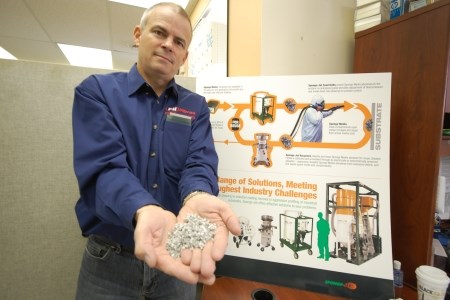A Sudbury industrial supplier is developing a green touch.
Fibron Inc. is now a Canadian distributor for an American-made environmentally friendly alternative to sandblasting.
The fifteen-year-old company has made its mark supplying spray-foam insulation, fireproofing services, epoxy lining and coatings, and concrete restoration, mostly for the commercial, industrial and residential sectors.
With 10 employees, they’re now in the process of rebranding themselves to better reflect their new services in concrete raising, undersealing and soil stabilization, and a new product called Sponge-Jet blasting.
Developed by Sponge-Jet Inc. of New Hampshire, Fibron offers a service to remove coatings from almost any kind of surface. Instead of blasting away with industrial sand, the process uses a pellet-ized urethane material called sponge media.
The best part is the system recycles and reuses its materials, which reduces waste, hazardous airborne emissions and loss of productivity.
“The whole theory behind Sponge-Jet technology is to find a way to reduce worker fatigue, injuries, dust and debris, and to provide something that is more environmentally friendly,” said Brad Shaw, Fibron’s president and general manager.
Shaw touts Sponge-Jet’s environmental cleanliness and increased safety, as well as how thoroughly it cleans the surface.
Compared to conventional abrasives, it reduces dust levels as much as 98 per cent and eliminates water, slurry or runoff problems.
Different aggregates are embedded into the sponge, like aluminum, plastic, steel or even powder in the less aggressive calcium carbonate sponge. Thus, the surface being cleaned and desired finish will determine the type of media used.
“We can sponge-blast decorative facades of government buildings without damaging the concrete or a 100-year-old wooden church door,” said Shaw.
Conventional sand-blasting abrasives, like copper slag for example, hit and bounce off a surface and fracture into multiple pieces at high speed, which is hazardous and creates plenty of dust particles. The sponge doesn’t refract and break apart, but instead expands on impact and drops off instead of ricocheting.
Like dust on the floor, the material can be vacuumed up and reused again as many as 18 times before having to add a new bag.
“We reuse the media up to 95 per cent of every process that goes through the unit,” Shaw said.
An LED light at the end of the spray nozzle allows the workers to see the surface being cleaned, which can be difficult if inside a dark tank.
Shaw said the product is environmentally approved for incinerators and any contaminants from the coatings are dealt with by the client under proper regulations. He also stressed the job site is left as clean as when they started.
He said that although the sponge product initially appears more expensive, its environmentally sound attributes and job performance actually save money.
Fibron stocks a B-VAC high-production system that can recover all the sponge material from jobs involving large bridges, buildings, tanks or rail cars.
Another newer division of Fibron is their concrete raising, undersealing and soil stabilization business. Shaw adopted this process a year ago to help municipalities add life to aging infrastructure. It uses high-density polyurethane foam to restore damaged or sinking concrete abutments, bridges, foundations and walkways. They can raise unbroken pieces of slab from a half-inch to six inches.
“If you have soil eroding, you can inject that (foam) into the soil,” Shaw said. “That product will solidify with the moisture in the soil, and turn it into a 1,600- to 2,000-pounds-per-square-inch concrete mix. It stops soil erosion and runoff.”
Although it is a seasonal service, Shaw sees a huge market in it. This past summer they worked on 60 sewer manholes in Elliot Lake instead of the municipality replacing them.
“We want to present it to the Ministry of Transportation, municipalities, and road contractors that have problems with installed work,” he said. “It is less expensive to them for us to come in and inject it.”
Fibron’s coverage area is between Parry Sound, North Bay and Sault Ste. Marie but Shaw said they will go anywhere in Ontario.




